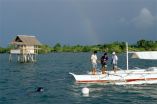(Press-News.org) Exposure to moderate amounts of sunshine may slow the development of obesity and diabetes, a study suggests.
Scientists who looked at the effect of sunlight on mice say further research will be needed to confirm whether it has the same effect on people.
The researchers showed that shining UV light at overfed mice slowed their weight gain. The mice displayed fewer of the warning signs linked to diabetes, such as abnormal glucose levels and resistance to insulin.
The beneficial effects of UV treatment were linked to a compound called nitric oxide, which is released by the skin after exposure to sunlight. Applying a cream containing nitric oxide to the skin of the overfed mice had the same effect of curbing weight gain as exposure to UV light, the team found.
Vitamin D – which is produced by the body in response to sunlight and often lauded for its health benefits – did not play a role, the study found.
The team says the new findings add to the growing body of evidence that supports the health benefits of moderate exposure to the sun's rays.
Previous studies in people have shown that nitric oxide can lower blood pressure after exposure to UV lamps.
The results should be interpreted cautiously, the researchers say, as mice are nocturnal animals covered in fur and not usually exposed to much sunlight. Studies are needed to confirm whether sunshine exposure has the same effect on weight gain and risk of diabetes in people.
Researchers at the Telethon Kids Institute in Perth, Western Australia, led the study in collaboration with the Universities of Edinburgh and Southampton.
Dr Shelley Gorman, of the Telethon Kids Institute and lead author of the study, said: "Our findings are important as they suggest that casual skin exposure to sunlight, together with plenty of exercise and a healthy diet, may help prevent the development of obesity in children."
"These observations further indicate that the amounts of nitric oxide released from the skin may have beneficial effects not only on heart and blood vessels but also on the way our body regulates metabolism," Dr Martin Feelisch, Professor of Experimental Medicine and Integrative Biology at the University of Southampton, added.
Dr Richard Weller, Senior Lecturer in Dermatology at the University of Edinburgh, said: "We know from epidemiology studies that sun-seekers live longer than those who spend their lives in the shade. Studies such as this one are helping us to understand how the sun can be good for us. We need to remember that skin cancer is not the only disease that can kill us and should perhaps balance our advice on sun exposure."
The research is published today in the journal Diabetes.
INFORMATION:
OAKLAND, Calif., October 23, 2014 – Women who developed gestational diabetes and were overweight before pregnancy were at a higher risk of having daughters who were obese later in childhood, according to new research published today in Diabetes Care.
Based on long-term research that included a multi-ethnic cohort of 421 girls and their mothers (all members of Kaiser Permanente Northern California), the study is among the first to directly link maternal hyperglycemia (high blood glucose) to offspring being overweight later.
"Glucose levels during pregnancy, particularly ...
DOWNERS GROVE, Ill. – October 23, 2014 – An international multicenter study reports that over-the-scope clip (OTSC) placement is a safe and effective therapy for the closure of gastrointestinal (GI) defects, which includes anastomotic leaks, fistulae and perforations. Clinical success was best achieved in patients undergoing closure of perforations or leaks when OTSC placement was used for primary or rescue therapy. The overall clinical success for the closure of perforations and leaks ranged between 90 percent and 73 percent; however, successful closure of ...
An ocean's oxygen levels may play a role in the impact of marine predators on bodies when they are immersed in the sea, according to Simon Fraser University researchers in a new study published this week in the journal PLoS One.
SFU criminologist Gail Anderson led the study, based on the deployment of a trio of pig carcasses into Saanich Inlet at a depth of 100 metres and studied over the past three years. Anderson assessed scavenger activity while co-author and SFU criminologist Lynne Bell continues her investigation of what happens to submerged bones.
The work is ...
Subjective screening questions do not reliably identify teenagers who are at risk for hearing loss, according to researchers at Penn State College of Medicine. The results suggest that objective hearing tests should be refined for this age group to replace screening questions.
The American Academy of Pediatrics, in partnership with the Bright Futures children's health organization, sets standards for pediatric preventive care. The AAP recommends screening adolescents with subjective questions and then following up with objective hearing tests for those found to be at ...
Just like those of humans, insect guts are full of microbes, and the microbiota can influence the insect's ability to transmit diseases. A study published on October 23rd in PLOS Pathogens reports that a bacterium isolated from the gut of an Aedes mosquito can reduce infection of mosquitoes by malaria parasites and dengue virus. The bacterium can also directly inhibit these pathogens in the test tube, and shorten the life span of the mosquitoes that transmit both diseases.
George Dimopoulos and colleagues from Johns Hopkins University, USA, had previously isolated Csp_P, ...
Orono, Maine — In the southern Peruvian Andes, an archaeological team led by researchers at the University of Maine has documented the highest altitude ice age human occupation anywhere in the world — nearly 4,500 meters above sea level (masl).
Their discoveries date high-altitude human habitation nearly a millennium earlier than previously documented.
Despite cold temperatures, high solar radiation and low oxygen conditions at that altitude, hunter-gatherers colonized the remote, treeless landscapes about 12,000 years ago during the terminal Pleistocene ...
LA JOLLA, CA – October 23, 2014 - Breaking carbon-hydrogen (C-H) bonds to alter existing molecules to create new ones is an increasingly important avenue for drug development. Of particular interest is mirror-image or "one-handed" compounds, but C-H breaking methods for making pure batches of these molecules have worked with only a limited range of starting materials.
Now a team from The Scripps Research Institute (TSRI) has established a new C-H activation technique that opens the door to creating a broader range of pure molecules of one-handedness or "chirality" ...
DURHAM, N.C. -- When pathogenic bacteria like Salmonella or Staphylococcus invade a host, the host organism should respond by going into a state of high alert, altering its metabolism to defend against the attack.
But if the host doesn't reverse course once the battle is won, its efforts will be wasted on defense rather than on repairing the damage done by bacterial invaders.
Duke University researchers have uncovered the genes that are normally activated during recovery from bacterial infection. The finding could lead to ways to jumpstart this recovery process and ...
Over the last decade, powerful new microscopes have dramatically sharpened biologists' focus on the molecules that animate and propel life. Now, a new imaging platform developed by Eric Betzig and colleagues at the Howard Hughes Medical Institute's Janelia Research Campus offers another leap forward for light microscopy. The new technology collects high-resolution images rapidly and minimizes damage to cells, meaning it can image the three-dimensional activity of molecules, cells, and embryos in fine detail over longer periods than was previously possible.
The developers ...
To protect our oceans from irreversible harm, governments, conservationists, and researchers around the world must address the enormous threat posed by unregulated and destructive fisheries, say top marine scientists.
In an article published today in Science, Prof. Amanda Vincent of Project Seahorse at the University of British Columbia and Dr. Jean M. Harris of Ezemvelo KZN Wildlife in South Africa call for bold new approaches to the pressing global issue of overfishing and habitat destruction, including networks of marine protected areas, co-ordinated governance, and ...


